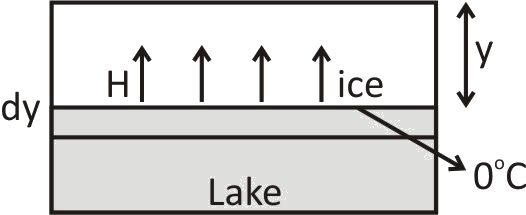Question
Question: A layer of ice of thickness y is on the surface of a lake. The air is at constant temperature \[ - \...
A layer of ice of thickness y is on the surface of a lake. The air is at constant temperature −θ°C and the ice water interface is at 0∘. Then that the rate at which the thickness increases is given by.
dtdy=Lρykθ
Where k is the thermal conductivity of the ice, L is the latent heat of fusion and ρ is the density of the ice. Type 1 for true and 0 for false.
Solution
As in the question thickness of layer of ice is given and also air at constant temperature and ice water interface is also given. Temperature of water is more than the ice, so heat will be there that is going from water to air through ice. By considering this, we can easily find the rate at which the thickness will be increased.
Complete step by step solution:
Consider one lake and it is having a layer of ice on its surface as shown. The thickness of the ice is y and the air is at constant temperature −θ°C and the ice water interface is at 0∘.
Rate at which the thickness increases, dtdy=Lρykθ
Where k is the thermal conductivity of the ice, L is the latent heat of fusion and ρ is the density of the ice.

As heat will be going from water to air through ice, so
H=RΔT
R0−(θ)=Rθ ----- (1)
We know,
H=dtdQ ------ (2)
Compare equation (1) and (2), we get-
dQ=Rθ.dt ---- (3)
Also, R=kAt
Here t is thickness, A is area and K is thermal conductivity.
R=kAy
Substitute the value of R in equation (3), we get-
dQ=yθkA.dt
This dQ is the heat that is going from water to air through ice. Using this much amount of heat, ice formed and dy layer of ice is increased (as shown)
If Q heat is used then, Q=m×L
Here L is the latent heat of the fusion.
We know, m=v×ρ (mass= volume× density)
=A×dy×ρ×L
dQ=yθkA.dt
Ady.L.ρ=yθkA.dt
So, dtdy=y.A.L.ρθkA
dtdy= Lρyθk
So, this is true.
Note:
The latent heat of fusion is the amount of heat that is gained by solid substance to convert into liquid without any other increase in temperature.
Or we can also solve directly by rate of loss of heat = L.Aρdtdy =yKθA
By comparing equations, we will get the dtdy
